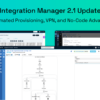For banks and credit unions, digital transformation initiatives have a common starting point – the need to deliver faster or integrate a new product or service. Financial services are evolving faster than ever before. To keep up, CTOs, CIOs, and CXOs scramble to speed up innovation, create faster processes, or realize new efficiencies to respond to customer demand. Unfortunately, banking core vendors present a challenge to rapid innovation. The core either can’t respond to the bank’s needs fast enough or offers proprietary solutions with high costs and solidifies the bank in vendor lockin. Sound familiar? In a recent webinar with our partner, FTSI, we covered the use cases our customers have overcome, how we removed vendor lock-in to leverage the core for what it does best, and revealed how easy it is to get started.
Beware, the origin of point-to-point architecture
How do banks get themselves into a technically gridlocked position in the first place? The answer has been different for each of our customers. But in every case, it wasn’t something that happened overnight. Maintenance mode can feel as if the institution is on cruise control and everything is fine. There is danger in this state of thinking. We find that when operations are humming along smoothly, it’s commonly due to development and architectural compromises that were made in the past. One by one, applications had been integrated with other internal systems, creating a brittle point-to-point architecture.
Innovation tips the balance. It’s not until the market forces the organization to quickly innovate that they find technical debt built up from years of cruising in maintenance mode. At this point, however, it’s too late to clean up. So, organizations add another point-to-point integration and acquire more technical debt.
What is the value of digital transformation?
At this stage in the journey, we meet customers who want to digitally transform but aren’t sure how to get started. For financial institutions, it’s essential to recognize that digital transformation means more than just modernizing your online applications. It’s rethinking the organization’s infrastructural capacity to deliver outcomes faster while reducing cost.
Digital transformation can unlock tremendous value to the financial institution in the form of immediate optimization, vendor independence, flexible integrations, speed of delivery, accurate, real-time customer data, and better service delivered to your customer.
Here’s a list of some of the use cases we’ve helped banks and credit unions modernize:
Loan/mortgage operations
- Loan origination and onboarding
- Loan processing/funding
- Loan servicing
- Mortgage defaults
- AI-supported loan approvals
Deposit operations
- Remote deposit capture
- Wire transfers
- Check adjustment processing
- Check holds
- Exception processing
Contact center
- Change of address
- Payment processing
- Password resets
- Data entry across applications
- Chatbots and voicebots
Branch
- New account opening
- Loan application processing
- Data entry
- Reconciliations
- Wire entry
- Teller integration
- ATM integration
Back office
- Customer or member 360
- Employee onboarding/offboarding
- Accounts payable
- Accounting reconciliation/balancing
The beauty of reuse
That list can strike anxiety in the heart of any seasoned technical leader. But it shouldn’t cause panic. You can digitally transform the organization one use case at a time. The best part is that as you modernize, each incremental project delivers greater business value and ROI as you go.
The solution is a vendor-agnostic integration platform. The goal is to break apart the individual connections so that the organization is not dependant on any of the outlying systems. This allows the bank to truly leverage its core vendor for what it should be – the ledger.
The Aha! Project
This approach enables you to start small and move fast. Digital transformation can be an overwhelming concept considering the number of applications in your IT landscape. However, you will be surprised by how low the impact on operations will be when you get started. The API-led approach results in reusable assets from each completed project. And, reuse creates value, speed, and the flexibility to add or remove applications.
It is the second project that we call “The Aha! project.” In a recent webinar with Kevin Guenthner, CIO of Stockman Bank, he shared his experiences throughout the digital transformation journey. In the bank’s second project, the team was able to reuse 75% of the APIs that were built in the first project. And, in our work with Solarity Credit Union, this approach resulted in an 18-month reduction in its project delivery cycle times.
How do I get started?
The results from this approach can sound too good to be true. We assure you that they are real experiences from real customers. Too many companies have made the mistake of considering integration an afterthought. Start thinking about integration before adding any new vendor or connecting any two systems.
We can help you get started. We begin with a discovery session to better understand the current state of your organization, its roadmap, where your pain points are, and establish use case priorities. If you would like to get started or just want to know more about our approach, check out our banking core integration and service delivery pages and get in touch with our team today.






